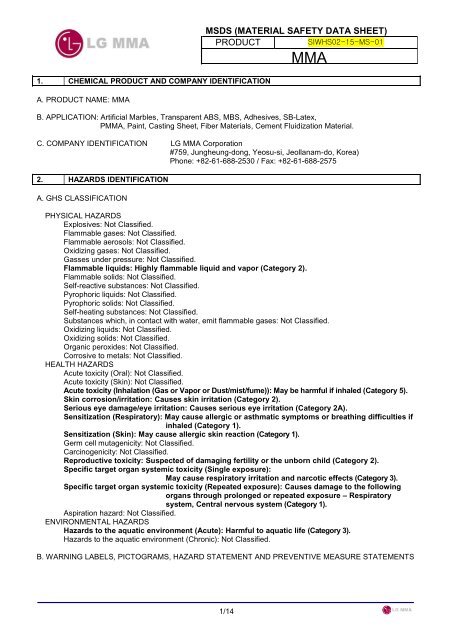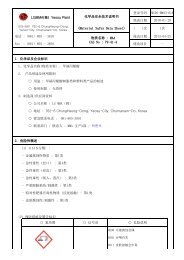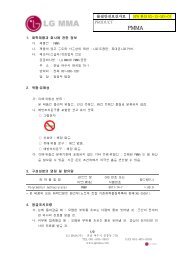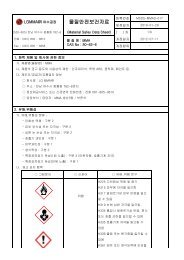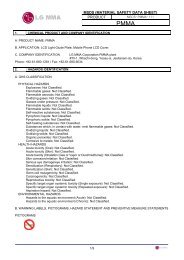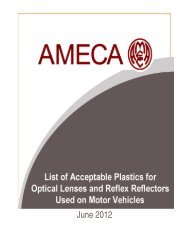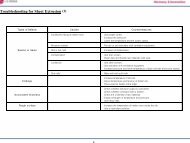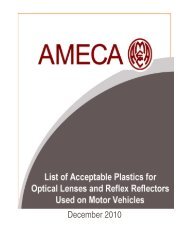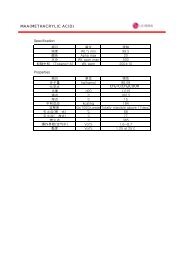Aluminu m Oxide MMA - LG MMA
Aluminu m Oxide MMA - LG MMA
Aluminu m Oxide MMA - LG MMA
You also want an ePaper? Increase the reach of your titles
YUMPU automatically turns print PDFs into web optimized ePapers that Google loves.
MSDS (MATERIAL SAFETY DATA SHEET)PRODUCT<strong>Aluminu</strong>m <strong>Oxide</strong>SIWHS02-15-MS-01<strong>MMA</strong>C. SPECIAL PROTECTIVE EQUIPMENT AND PRECAUTIONS FOR FIRE FIGHTERSIn case of fire, wear a full face positive-pressure self contained breathing apparatus and protective suit. Keepcontainers cool with water spray.6. ACCIDENTAL RELEASE MEASURESA. PERSONAL PRECAUTIONS, PROTECTIVE EQUIPMENT AND EMERGENCY PROCEDURESEliminate all ignition sources. Restrict access to area as appropriate until clean-up operations are complete. Usepersonal protective equipment recommended in Section 8 (Exposure Controls/Personal Protection). Stop orreduce any leaks if it is safe to do so. Ventilate spill area if possible. Ensure clean-up is conducted by trainedpersonnel only. Do not touch spilled material. Have emergency equipment (for fires, spills, leaks, etc.) readilyavailable. Notify appropriate government, occupational health and safety and environmental authorities.B. ENVIRONMENTAL PRECAUTIONSPrevent material from entering sewers or waterways. Notify appropriate government, occupational health andsafety and environmental authorities.C. METHODS AND MATERIALS FOR CONTAINMENT AND CLEANING UPSMALL SPILLS: Soak up spill with absorbent material (sand or other non combustible adsorbent material). Placeresidues in a suitable, covered, properly labeled container. Wash affected area.LARGE SPILLS: Contain liquid using absorbent material, by digging trenches or by diking. Reclaim into recoveryor salvage drums or tank truck for proper disposal. Clean contaminated surfaces with water or aqueous cleaningagents. Dispose of material in compliance with regulations indicated in Section 13 (Disposal Considerations).7. HANDLING AND STORAGEA. PRECAUTIONS FOR SAFE HANDLINGDo not get in eyes, on skin, on clothing. Do not take internally. Use with adequate ventilation. Do not breathevapors/gases/dust. In case of inadequate ventilation wear respiratory protection. Keep the containers closedwhen not in use. Use non-sparking type tools and equipment, including explosion proof equipment. Useconnections properly earthed to prevent generation of electrostatic charges. Vapors are heavier thanair and may travel considerable distances to a source of ignition and flash back. Have emergency equipment (forfires, spills, leaks, etc.) readily available. Ensure all containers are labelled. Do not use, store, spill or pour nearheat, sparks or open flame.B. CONDITIONS FOR SAFE STORAGE, INCLUDING ANY INCOMPATIBILITIESStore in suitable labelled containers. Store the containers tightly closed. Store away from heat and sources ofignition. Protect from direct sunlight. Keep containers placed in cool, well–ventilated areas at temperature notexceeding 30 ºC. Have appropriate fire extinguishers available in and near the storage area. Store separatelyfrom incompatibles. Connections must be grounded to avoid electrical charges.* Fill the container by approximately 90 % only as oxygen (air) is required for stabilization. With large storagecontainers, make sure the oxygen (air) supply is sufficient to ensure stability [ECETOC].8. EXPOSURE CONTROLS/PERSONAL PROTECTIONA. OCCUPATIONAL EXPOSURE LIMITSKOREAKorea. OELs (ISHL Article 42; MOL Public Notice No. 1986-45, as amended through MOL Public NoticeNo. 2007-25, June 8, 2007)CAS RN: 80-62-6Name: Methyl methacrylateThe 8-hour TWA: 50 ppm.The 8-hour TWA: 205 mg/m3The 15-minute STEL: 100 ppm.5/14
MSDS (MATERIAL SAFETY DATA SHEET)PRODUCT<strong>Aluminu</strong>m <strong>Oxide</strong>SIWHS02-15-MS-01<strong>MMA</strong>The 15-minute STEL: 410 mg/m3JAPANJapan. OELs - JSOH (Japan Society of Occupational Health: Recommendation of OccupationalExposure Limits, 2007)CAS RN: 80-62-6Name: Methyl methacrylateSkin sensitizer: 2 (Probable skin sensitizer).Respiratory sensitizer: 2 (Probable respiratory sensitizer)OSHAOSHA Table Z-1 Limits for Air Contaminants (June 30, 1993)(29 CFR 1910.1000)(1971 PermissibleExposure Limits (PELs))CAS RN: 80-62-6Name: Methyl methacrylateOSHA Z-1 PEL: 100 ppmOSHA Z-1 PEL: 410 mg/m3.ACGIHACGIH Threshold Limit Values (2007)CAS RN: 80-62-6Name: Methyl methacrylateSensitizerCarcinogen Category: A4 (Not Classifiable as a Human Carcinogen)The 8-Hour Exposure Limit (TLV-TWA): 50 ppm.The 15-minute STEL: 100 ppm.NIOSHNIOSH. Pocket Guide to Chemical Hazards, 2005CAS RN: 80-62-6Name: Methyl methacrylateNIOSH Recommended exposure limit (REL) [for up to a 10-hour workday during a 40-hourworkweek]: 100 ppm.NIOSH Recommended exposure limit (REL) [for up to a 10-hour workday during a 40-hourworkweek]: 410 mg/m3.NIOSH Immediately dangerous to life or health (IDLH) concentration: 1,000 ppm.B. ENGINEERING MEASURESGeneral ventilation is recommended. Use local exhaust ventilation if necessary to control airborne mist andvapor. Provide mechanical ventilation of confined spaces.C. INDIVIDUAL PROTECTION MEASURESGENERAL ADVICEThe use and choice of personal protection equipment is related to the hazard of the product, the workplace andthe way the product is handled. In general, we recommend as a minimum precaution that safety glasses withside-shields and work clothes protecting arms, legs and body be used. In addition any person visiting an areawhere this product is handled should at least wear safety glasses with side-shields.RESPIRATORY PROTECTIONWhere concentrations in air may exceed the limits given in this section, the use of a half face filter mask or airsupplied breathing apparatus is recommended. If significant mists, vapors or aerosols are generated anapproved respirator is recommended. A suitable filter material depends on the amount and type of chemicalsbeing handled. If respiratory protection is required, institute a complete respiratory protection program includingselection, fit testing, training, maintenance and inspection.HAND PROTECTIONIt has been demonstrated that <strong>MMA</strong> easily penetrates rubber latex gloves. All vinyl gloves appeared to providepoorer protection. Polyethylene gloves give the best protection against <strong>MMA</strong> diffusion.6/14
MSDS (MATERIAL SAFETY DATA SHEET)PRODUCT<strong>Aluminu</strong>m <strong>Oxide</strong>SIWHS02-15-MS-01<strong>MMA</strong>Gloves should be replaced immediately if signs of degradation are observed. Most glove materials are of lowchemical resistance. Consult PPE manufacturers. Replace gloves regularly.SKIN PROTECTIONWhen handling this product, the use of a chemical resistant suit and rubber boots is recommended. Keep asafety shower available.EYE PROTECTIONWhen handling this product, the use of splash chemical goggles is recommended. Keep an eye wash fountainavailable.9. PHYSICAL AND CHEMICAL PROPERTIESA. PHYSICAL APPEARANCE: Clear, colorless liquid.B. ODOR: Characteristic odor.C. ODOR THRESHOLD: 0.05 – 0.34 ppm [Amoore J.E., Hautala E.: Odor as anaid to chemical safety: odor thresholds compared withthreshold limit values and volatilities for 214 industrialchemicals in air and water dilution; J. Appl. Toxicol. 3:272–290 (1983)]D. pH: No data available.E. MELTING/FREEZING POINT: -48°C [Method: Directive 84/449/EEC, A.1 "Meltingpoint/melting range"]F. INITIAL BOILING POINT/BOILING POINT RANGE: 101°C [Method: Directive 84/449/EEC, A.2 "Boilingpoint/boiling range"]G. FLASH POINT: 10°C (Open Cup) [Method: Directive 84/449/EEC, A.9"Flash point" or ASTM D. 92–52]H. EVAPORATION RATE: 3.1 (Ethyl acetate = 1)I. FLA<strong>MMA</strong>BILITY (GAS, SOLID): Not applicable.J. UPPER AND LOWER EXPLOSION LIMITS: 1.7 – 12.5 [ICSC]K. VAPOUR PRESSURE: 3.9kPa [ICSC].L. SOLUBILITY: 15g/L (water, 20°C) [Method: Directive 84/449/EEC,A.6 "Water solubility"]M. RELATIVE VAPOUR DENSITY: 3.5 (air=1, 20°C) [ICSC and IUCLID]N. SPECIFIC GRAVITY: 0.944O. n-OCTANOL/WATER PARTITION COEFFICIENT: 1.38 [Method: other (measured): as OECD 107, flaskshaking method]P. AUTOIGNITION TEMPERATURE: 421°C (1,013 hPa)Q. DECOMPOSITION TEMPERATURE: No data available.R. VISCOSITY: 0.60 mPa s at 20°C (method: DIN 51 562)10. STABILITY AND REACTIVITYA. CHEMICAL STABILITYInhibited methyl methacrylate is stable at room temperature for a limited storage period. Vapors are uninhibitedand may form polymers in vents, causing stoppage. Polymerization may be caused by elevated temperature,oxidizers, peroxides, or sunlight.B. POSSIBILITY OF HAZARDOUS REACTIONSThe product is readily polymerized by light, heat, or oxidants without inhibitor. If the polymerization takes placeinside some containers, it is subject to violent rupture [IUCLID].C. CONDITIONS TO AVOIDInsufficient inhibitor, incompatibles, heat, flame and ignition sources.D. INCOMPATIBLE MATERIALS7/14
MSDS (MATERIAL SAFETY DATA SHEET)PRODUCT<strong>Aluminu</strong>m <strong>Oxide</strong>SIWHS02-15-MS-01<strong>MMA</strong>Contact with polymerization catalysts (e.g. peroxides, persulfates), nitric acid, strong oxidizers and other bases(e.g. ammonia, amines), halogens and halogen compounds.E. HAZARDOUS DECOMPOSITION PRODUCTS<strong>Oxide</strong>s of carbon (COx).11. TOXICOLOGICAL INFORMATIONA. INFORMATION ON THE LIKELY ROUTES OF EXPOSUREEYE CONTACT: Yes.SKIN CONTACT: Yes.INGESTION: No.INHALATION: Yes (vapor, mist).B. SYMPTOMS RELATED TO THE PHYSICAL, CHEMICAL AND TOXICOLOGICAL CHARACTERISTICSNo data available.C. DELAYED AND IMMEDIATE EFFECTS AND ALSO CHRONIC EFFECTS FROM SHORT AND LONG TERMEXPOSUREACUTE TOXICITY:- Oral: The product is not acute toxic according to GHS (Globally Harmonized Systems classification system).- Skin: The product is not acute toxic according to GHS (Globally Harmonized Systems classification system).- Inhalation: Mist or vapor may irritate the respiratory tract. Mist or vapor may cause headache, chest pain,vomiting, nausea and narcosis. Very high levels may cause pulmonary edema and death.SKIN CORROSION/IRRITATION:Causes irritation to skin.SERIOUS EYE DAMAGE/IRRITATION:Irritating, and may injure eye tissue if not removed promptly.RESPIRATORY OR SKIN SENSITIZATION:Prolonged or frequently repeated skin contact may cause allergic reactions in some individuals.Inhalation of product mist or vapors may cause respiratory allergy in some individuals.GERM CELL MUTAGENICITY:Not expected to cause mutagenicity based on some mutagenicity assay.CARCINOGENICITY:IARC Overall Evaluation: 3 (not classifiable as to carcinogenicity in humans).ACGIH Carcinogen Category: A4 (not classifiable as to carcinogenicity in humans).None of the substances in this product are listed as carcinogens in humans by the International Agency forResearch on Cancer (IARC), American Conference of Governmental Industrial Hygienists (ACGIH) or theNational Toxicology Program (NTP).REPRODUCTIVE TOXICITY:Caused teratogenic effects (maternally toxic, foetal toxicity) on laboratory animals [EU-RAR No.22 (2002)].SPECIFIC TARGET ORGAN/SYSTEMIC TOXICITY – SINGLE EXPOSURE:May cause respiratory irritation and narcotic effects.8/14
MSDS (MATERIAL SAFETY DATA SHEET)PRODUCT<strong>Aluminu</strong>m <strong>Oxide</strong>SIWHS02-15-MS-01<strong>MMA</strong>SPECIFIC TARGET ORGAN/SYSTEMIC TOXICITY – REPEATED EXPOSURE:Causes damage to respiratory system and central nervous system through prolonged or repeated exposure.ENVIRONMENTAL HEALTH CRITERIA:None known. No data available.ASPIRATION HAZARD:None known. No data available.D. NUMERICAL MEASURES OF TOXICITY (SUCH AS ACUTE TOXICITY ESTIMATES)ACUTE ORAL TOXICITY:Species LD50 Test Descriptor / ReferenceRat 7,872 mg/kg RTECSACUTE DERMAL TOXICITY:Species LD50 Test Descriptor / ReferenceRabbit > 5,000 mg/kg RTECSACUTE INHALATION TOXICITY:Species LC50 Test Descriptor / ReferenceRat 78,000 mg/m3/4hrs RTECSSKIN IRRITATION:Rabbit 0.5 ml, occluded, 4 hour, effect: Moderately irritating [Rohm and Haas (1982)].EYE IRRITATION:Rabbit, effect: Moderately irritating [Rohm and Haas (1988)].MUTAGENICITY:Salmonella typhimurium reverse mutation assay: 10–10,000 ug/plate (+-S9), result: negative (OECD 471 (1987)).Micronucleus assay (in vivo): mouse, result: negative (Method: OECD 474 (1991)).SENSITIZATION:Guinea pig (guinea pig maximization test), result: sensitizing.For sensitization, the experimental dentin primers were diluted with olive oil and acetone 7 : 3 (v/v). As antigen<strong>MMA</strong> was tested at concentrations of 0.2, 1 and 5 % by weight [Katsuno K., Manabe A., Itoh K., Hisamitsu H.,Wakumoto S., Nakayama S., Yoshida T.; A delayed hypersensitivity reaction to dentin primer in the guinea pig;J. Dent. 23(5): 295 – 299 (1995)].12 ECOLOGICAL INFORMATIONA. TOXICITYACUTE FISH RESULTS:Species Exposure LC50 Test Descriptor / ReferenceLepomis macrochirus 96 hrs 191 mg/L EPA, 1975Oncorhynchus mykiss 96 hrs > 79 mg/LEPA, 40 CFR Part 797 Guideline797.1400ACUTE INVERTEBRATE RESULTS:Species Exposure EC50 Test Descriptor / ReferenceDaphnia magna (Crustacea) 48 hrs 69 mg/L EPA, 1975, flow through protocolDaphnia magna (Crustacea) 24 hrs720 mg/L1,042 mg/L (EC100)-9/14
MSDS (MATERIAL SAFETY DATA SHEET)PRODUCT<strong>Aluminu</strong>m <strong>Oxide</strong>SIWHS02-15-MS-01<strong>MMA</strong>AQUATIC PLANTS (e.g. A<strong>LG</strong>AE) RESULTS:Species Exposure EC50 Test Descriptor / ReferenceScenedesmus quadricauda(Algae)7 days 37 mg/L -Scenedesmus quadricauda(Algae)4 days 170 mg/L OECD Guideline 201 (1990)B. PERSISTENCE AND DEGRADABILITYThe organic portion of this substance is expected to be biodegrade to a moderate extent.- Biodegradation: 88 % after 28 days (aerobic).* 60 % biodegradation was not reached within 10 days of passing the 10 % levelResult: Not readily biodegradable according to EEC criteria [OECD–guideline 301 D, GLP (1992)].- Biodegradation: 32 % after 28 days (aerobic)[OECD Guide–line 301 C "Ready Biodegradability: Modified MITI Test (I)" (1989)].- Biodegradation: 94.3 % (14 days (BOD test)) [Safety assessment for Existing Chemicals, JAPAN (1992)].C. BIOACCUMULATIVE POTENTIAL<strong>MMA</strong> is not expected to significantly bioaccumulation due to low bioaccumulation factor (BCF).- BCF = 2 – 6.59 (Method: calculated) [Lyman W.J., Reehl W.F., Rosenblatt D.H.; Handbook of chemicalproperty estimation methods; Environmental behavior of organic compounds; McGraw–Hill, New York, NY,4.2–4.33, 5.1–5.30 (1982)]- BCF = 2.350 (Method: calculated) [Safety assessment for Existing Chemicals, JAPAN (2002)]D. MOBILITY IN SOILIf <strong>MMA</strong> released into the soil, <strong>MMA</strong> is expected to quickly evaporate.On the basis of its vapor pressure and its low absorption to soil (K= 21.3 – 34), <strong>MMA</strong> is expected to volatilizerelatively rapidly from soil [Online literature search, Environfate data base, 1991 SRC, 1988].E. OTHER ADVERSE EFFECTSNone known. No data available.13. DISPOSAL CONSIDERATIONSA. DISPOSAL METHODSMust be disposed of as a special waste in accordance with regulations for special waste.Small quantities may be incinerated under controlled conditions in incinerators suitable for methacrylates.Hazardous wastes must be transported by a licensed hazardous waste transporter and disposed of or treated ina properly licensed hazardous waste treatment, storage, disposal or recycling facility.Consult local, state, and federal regulations for specific requirements.B. PRECAUTIONS (ON DISPOSAL OF COTAMINATED CONTAINERS AND PACKAGES)Do not dispose of wastes in local sewer or with normal garbage. Combustion products are carbon monoxide,carbon dioxide and water.14. TRANSPORT INFORMATION* The following results are for the product.A. UN NUMBER: 1247.B. UN PROPER SHIPPING NAME: METHYL METHACRYLATE MONOMER, STABILIZED.* Technical Name(s) -C. TRANSPORT HAZARD CLASS(ES): 3.10/14
D. PACKING GROUP, IF APPLICABLE: II.MSDS (MATERIAL SAFETY DATA SHEET)PRODUCT<strong>Aluminu</strong>m <strong>Oxide</strong>SIWHS02-15-MS-01<strong>MMA</strong>E. ENVIRONMENTAL HAZARDS: Not regulated.F. SPECIAL PRECAUTIONS FOR USER: No data available.15. REGULATORY INFORMATIONSAFETY, HEALTH AND ENVIRONMENTAL REGULATIONSEUROPE: This chemical substance is classified in the Annex I of Directive 67/548/EEC.Hazard symbols:Indication(s) of danger:F, XiRisk phrases:R11: Highly flammable.R37/38: Irritating to respiratory system and skin.R43: May cause sensitization by skin contact.Safety phrases:S2: Keep out of the reach of children.S24: Avoid contact with skin.S37: Wear suitable gloves.S46: If swallowed, seek medical advice immediately and show this container or label.U.S. FEDERAL, ENVIRONMENTClean Air Act Section 111, SOCMI Intermediate or Final Volatile Organic Compounds (40 CFR 60.489)CAS RN: 80-62-6Name: METHYL METHACRYLATEClean Air Act Section 112, Hazardous Air Pollutants, as amended by 40 CFR 63 (December 19, 2005)CAS RN: 80-62-6Name: METHYL METHACRYLATEHazardous Organic NESHAP (HON) Synthetic Organic Chemicals (40 CFR 63.100-.106, Table 1)CAS RN: 80-62-6Name: METHYL METHACRYLATEHazardous Organic NESHAP (HON) Hazardous Air Pollutants (40 CFR 63.100-.106, Table 2)CAS RN: 80-62-6Name: METHYL METHACRYLATEClean Water Act Section 311 Hazardous Chemicals (40 CFR 116.4)CAS RN: 80-62-6Name: METHYL METHACRYLATEClean Water Act Section 311 Hazardous Substances (40 CFR 117.3)CAS RN: 80-62-6Name: METHYL METHACRYLATEThe Reportable Quantity Code: CThe Reportable Quantity is:1000 lbs.RCRA Appendix VII: Hazardous Constituents (40 CFR 261, App. VII, Basis for Listing Hazardous Waste)CAS RN: 80-62-6Name: METHYL METHACRYLATERCRA Appendix VIII List of Hazardous Constituents (40 CFR 261)11/14
MSDS (MATERIAL SAFETY DATA SHEET)PRODUCT<strong>Aluminu</strong>m <strong>Oxide</strong>SIWHS02-15-MS-01<strong>MMA</strong>CAS RN: 80-62-6Name: 2-PROPENOIC ACID, 2-METHYL-, METHYL ESTEREPA Hazardous Waste Number: U162RCRA D List of Characteristic Hazardous Wastes (40 CFR 261.21-24)CAS RN: 80-62-6 regulated as a member of the Generics group for CAS RN: D001Generics group name: UNLISTED HAZARDOUS WASTE: CHARACTERISTIC OF IGNITABILITYThe EPA Hazardous Waste Number: D001NIOSH Recommended Safety and Health Standards for Hazardous Agents in the Workplace, Health EffectsCAS RN: 80-62-6Name: METHYL METHACRYLATENIOSH Health Effects: Respiratory irritationU.S. FEDERAL, RIGHT-TO-KNOWCERCLA Hazardous Substances [other than radionuclides] (40 CFR 302.4)CAS RN: 80-62-6Name: 2-PROPENOIC ACID, 2-METHYL-, METHYL ESTERThe Reportable Quantity (RQ):1000 lbs.EPCRA (SARA Title III) Section 313 Toxic Chemical (Reporting Form R Instructions for 2006, as revised January2007)CAS RN: 80-62-6Name: METHYL METHACRYLATEDe Minimis Concentration for Section 313:1.0 %.Reporting threshold for manufacturing and processing: 25000 lbsReporting threshold for other uses: 10000 lbsHMIS Chemical Ratings (Hazardous Materials Information System, Chemical Ratings Guide, Third Edition, 2002)CAS RN: 80-62-6Name: METHYL METHACRYLATEHealth Hazard: 2 Moderate.Chronic Health Hazard: -Flammability Hazard: 3 Serious.Physical Hazard: 1 Slight.CANADACanada. WHMIS Ingredient Disclosure List (Can. Gaz., Part II, Vol.122, No.2, January 20, 1988)CAS RN: 80-62-6Name: METHYL METHACRYLATECanada's WHMIS item number from English Ingredient Disclosure List: 1059Canada's WHMIS Concentration Threshold: 1 %.Quebec. Guidance WHMIS Classifications (CSST/SRT), May 5, 2007CAS RN: 80-62-6Name: METHYL METHACRYLATEClassification: B2, D2BDisclosure level: 1.0 %Disclosure according to Ingredient Disclosure ListCHINAChina. List of Dangerous Goods (GB 12268-2005)CAS RN: 80-62-6Name: METHYL METHACRYLATE MONOMER, STABILIZEDUN Dangerous Goods Number(s) (UN Number): 1247Dangerous Goods Classification(s): 3Dangerous Goods Packing Group(s): IIChina Dangerous Goods Number(s) (CN Number): 32149Note(s): Flammable liquidsChina. Classification and Labeling of Dangerous Chemical Substances Commonly Used (GB 13690 - 92)CAS RN: 80-62-6Name: METHYL METHACRYLATE (STABILIZED)12/14
MSDS (MATERIAL SAFETY DATA SHEET)PRODUCT<strong>Aluminu</strong>m <strong>Oxide</strong>SIWHS02-15-MS-01<strong>MMA</strong>Classification Section: Class 3: Combustible Liquids: Medium flashing point liquidClassification: F (Flammable)Dangerous Properties: 5.22, 5.104, 5.109Labeling: Exposure to excessive heat, open flame or strong oxidizing agents can readily cause fire.KOREAKorea. Dangerous Substances Threshold Quantity (Presidential Decree of Dangerous Substances SafetyManagement Act No. 18406, Schedule 1, May 29, 2004)CAS RN: 80-62-6Generics group name: No. 1 water-insoluble petroleum liquids with a flash point below 21°CClass: 4 (Flammable Liquids)Threshold quantity: 200 litersNATIONAL FIRE PROTECTION ASSOCIATION - NFPA Ratings (USA)Health: 2, Flammability: 3, Reactivity: 2, Specific hazard: -0 = Insignificant 1 = Slight 2 = Moderate 3 = High 4 = ExtremeINTERNATIONAL CHEMICAL CONTROL LAWSEUROPEThe substance in this product is included in or exempted from the EINECS or ELINCS inventories.U.S.The substance in this product are included on or exempted from the TSCA 8(b) Inventory (40 CFR 710).JAPANThe substance in this product is comply with the Law Regulating the Manufacture and Importation of ChemicalSubstances and are listed on the Ministry of Economy, Trade and Industry (METI).KOREAThe substance in this product is comply with the Toxic Chemical Control Law (TCCL) andis listed on the Existing Chemicals Inventory (KECI).Toxic Chemicals List - None of the component of this product is regulated under TCCL.Observational Chemicals List - None of the component of this product is regulated under TCCL.16. OTHER INFORMATIONThis product material safety data sheet provides health and safety information. The above information isbelieved to be correct but does not propose to be all inclusive and shall be used only as a guide. <strong>LG</strong> <strong>MMA</strong>Corporation shall not be held liable for any damage resulting from handling or from contact with the aboveproduct. Each individual should make a determination as to the suitability of the information for their particularpurpose(s). Various government agencies may have specific regulations regarding the transportation, handling,storage, use, or disposal of this product which may not be covered by this MSDS. The user is responsible for fullcompliance.A. REFERENCESGuideline for Globally Harmonized System of Classification and Labelling of Chemicals (GHS).Regulated chemicals info. produced by the National Institute of Technology and Evaluation (Japan).WHO/IPCS:International Chemical Safety Cards (ICSC).EU European Chemicals Bureau (ECB): International Uniform Chemical Information Database (IUCLID).Registry of Toxic Effects of Chemical Substances (NIOSH).Registry of Toxic Effects of Chemical Substances (RTECS).Joint Assessment of Commodity Chemicals, Methyl methacrylate No. 30, European Centre for Ecotoxicologyand Toxicology of Chemicals, Brussels (1995) (ECETOC).European Union Risk Assessment Report (European Commission) (EU-RAR).13/14
Ariel WebInsight DB (3E Company).MSDS (MATERIAL SAFETY DATA SHEET)PRODUCT<strong>Aluminu</strong>m <strong>Oxide</strong>SIWHS02-15-MS-01<strong>MMA</strong>B. OTHER INFORMATION- Date issued: 27 October 2007- Version number (GHS): 1.0- Technical Support on the MSDS: RGB Chemicals Co., Ltd. (http://rgbchemicals.com).14/14


